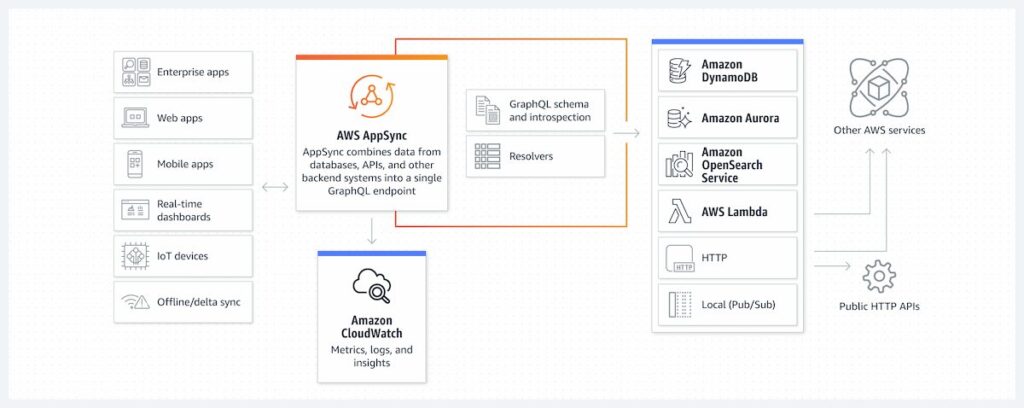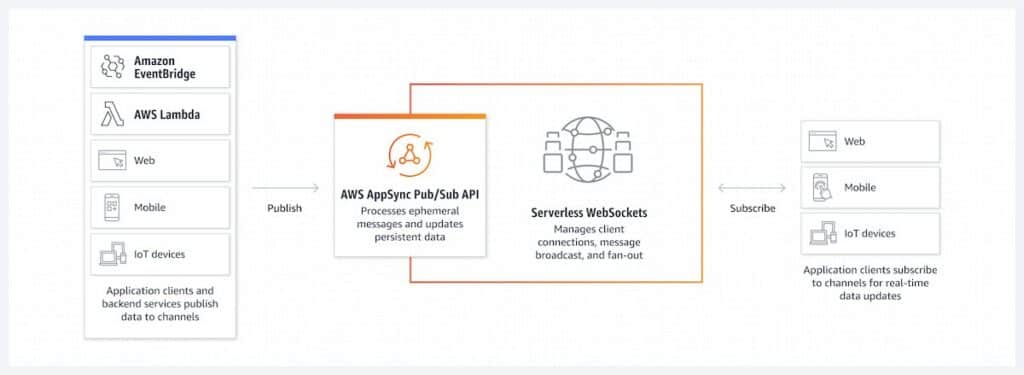AWS AppSync emerges as a pivotal solution, offering a managed GraphQL service that revolutionizes the way applications interact with data. As an advanced-tier AWS partner, Cloudvisor is committed to guiding you through the intricacies of AWS AppSync, ensuring you harness its full potential to streamline your data operations.
Table of Contents
What is GraphQL?
GraphQL stands for Graph Query Language, a powerful query language for APIs and a runtime for fulfilling those queries with your existing data. It represents a significant leap in the world of API development, introducing a more efficient, powerful, and flexible approach to data retrieval and manipulation.
The Essence of GraphQL: A Query Language for Your API
GraphQL is not just a technology; it’s a new paradigm for building and interacting with APIs. Unlike traditional REST APIs that require loading from multiple URLs, GraphQL APIs get all the data your app needs in a single request. Apps using GraphQL can be quick even on slow mobile network connections.
How GraphQL Transforms Data Retrieval
GraphQL allows clients to define the structure of the data required, and the server returns data in the exact same structure. This eliminates the over-fetching and under-fetching issues associated with traditional REST APIs. It’s designed to make APIs fast, flexible, and developer-friendly.
The Benefits of Using GraphQL in Modern Applications
- Efficient Data Loading: GraphQL enables precise data fetching. Clients can request exactly what they need, nothing more, nothing less. This efficiency is crucial for mobile networks with data usage concerns and latency.
- Real-Time Data with Subscriptions: GraphQL subscriptions maintain a steady connection to the server, allowing real-time data updates. This feature is invaluable for applications that require instant data refresh, like chat apps or live scores.
- Declarative Data Fetching: With GraphQL, you describe your data needs using a straightforward query language. The server then returns the data in a predictable format, making it easier to integrate and use in your application.
- Strongly Typed Schema: GraphQL APIs are organized in terms of types and fields, not endpoints. This strong typing allows introspective queries, giving developers the power to query the API for the types it supports.
By integrating GraphQL with AWS AppSync, you leverage these benefits while enjoying the AWS ecosystem’s scalability, security, and reliability. This combination paves the way for building dynamic, efficient, and robust applications.
What is AWS AppSync?
AWS AppSync transcends the traditional boundaries of a service; it’s a revolutionary approach that redefines how application data is managed and synchronized across platforms. This service is not just about facilitating data retrieval; it’s about reshaping the entire data interaction landscape. AWS AppSync empowers developers to craft applications that are not only flexible and scalable but also capable of real-time operations, all through the provision of a robust GraphQL API.
This API serves as a unified gateway, a single point of convergence where data from diverse sources like databases, microservices, and APIs coalesce. With AWS AppSync, the complexities of managing multiple endpoints are eliminated, replaced by a streamlined process where a single network request fetches all necessary data, ensuring efficiency and coherence in data retrieval and management.
The Architecture of AWS AppSync
Delving into the architectural essence of AWS AppSync reveals a system meticulously engineered to simplify the application development process. At the heart of this system lies the automatic management of WebSocket connections, a feature pivotal for real-time data distribution. This management ensures that applications are not just functioning but are responsive, up-to-date, and in sync with the dynamic data flow that modern applications necessitate.
The serverless nature of AWS AppSync’s architecture is a game-changer. It liberates developers from the intricacies and overheads associated with backend data management. This shift in focus from backend logistics to the actual creation of compelling and dynamic user experiences is not just a step but a leap toward innovation and efficiency. The serverless paradigm embedded within AWS AppSync means that resources are utilized more effectively, scalability is a given, and the application’s performance is optimized, all while ensuring that the backend complexities are handled seamlessly by AWS.
How Does AWS AppSync Work?
AWS AppSync is a managed service that simplifies the process of building scalable applications on the AWS platform by providing a flexible, serverless backend for web and mobile applications. It operates on the robust foundation of GraphQL, a powerful query language that allows clients to request exactly the data they need, nothing more, nothing less.
GraphQL APIs
GraphQL APIs constructed using AWS AppSync enable frontend developers to access a variety of databases, microservices, and APIs through a unified GraphQL endpoint.

Pub/Sub APIs
Pub/Sub APIs developed with AWS AppSync empower frontend developers to disseminate real-time data updates to connected API clients via serverless WebSocket connections.

How AWS AppSync Enhances Application Development
AWS AppSync is more than just a query language; it’s a comprehensive solution that addresses various aspects of application development.
Streamlining Data Access with GraphQL APIs
The GraphQL APIs built with AWS AppSync enable frontend developers to access multiple data sources through a single, unified endpoint. This not only simplifies the data retrieval process but also significantly reduces the complexity of your applications, leading to faster load times and a more seamless user experience.
Real-Time Data Synchronization with Pub/Sub APIs
AWS AppSync excels in delivering real-time experiences. Its Pub/Sub APIs allow developers to publish data updates instantly, ensuring that all subscribed clients receive the latest information without delay. This feature is particularly beneficial for applications that rely on real-time data, such as chat applications, live sports updates, or stock price monitoring.
Harnessing the Power of AWS AppSync for Contemporary Application Development
AWS AppSync is more than a mere tool; it’s a strategic asset intricately designed to meet and exceed the multifaceted demands of modern application development. This powerful service not only streamlines the development process but also enriches it with robust features, ensuring your applications are not just functional but also resilient and forward-thinking.
Enhanced Data Management and Uncompromised Security
At the core of AWS AppSync’s capabilities is its profound commitment to simplified data management and uncompromised security. This service is engineered to provide a secure environment where applications can effortlessly access, manipulate, and amalgamate data from various sources. AWS AppSync stands as a bulwark, ensuring that your data is not only accessible but also consistently reliable and secure, even when faced with the most complex and demanding scenarios.
Offline Data Synchronization and Conflict Resolution
One of the standout features of AWS AppSync is its innate ability to handle offline data synchronization and conflict resolution. This feature is particularly crucial in today’s mobile-first world, where consistent data access is necessary, regardless of network connectivity. AWS AppSync ensures that your application’s data remains synchronized, providing a seamless user experience that transcends the limitations of intermittent connectivity.
Robust Security Measures
Security in AWS AppSync is paramount. It incorporates industry-leading security measures to safeguard your data. With fine-grained access control, you can define precise security protocols, ensuring that every piece of data is accessed only by authorized entities. This meticulous approach to security not only protects your data but also fortifies the trust of your users.
Seamless Integration with the AWS Ecosystem
AWS AppSync’s prowess is further amplified by its seamless integration with the AWS ecosystem. This integration is a testament to the harmonious interplay between AWS AppSync and other AWS services, such as AWS Lambda, Amazon DynamoDB, and Amazon RDS.
Leveraging Existing AWS Resources
The ability to leverage existing AWS resources is a significant advantage. It eliminates the need for redundant, custom code, expediting development. This integration allows developers to tap into the vast array of AWS services, harnessing their power to build more robust, scalable, and efficient applications.
Streamlining the Development Process
The integration of AWS AppSync with the AWS ecosystem streamlines the entire development process. It provides a cohesive, well-orchestrated environment where every component works in unison, driving efficiency and reducing the time-to-market for your applications. This streamlined process accelerates development and ensures that your applications are built on a solid, reliable, and scalable foundation.
How does AppSync Integrate with Other AWS Services?
AWS AppSync’s true strength lies in its seamless integration with a broad array of AWS services, forming a cohesive and powerful ecosystem that enhances the capabilities of your applications. This integration is pivotal, as it allows developers to leverage the full suite of AWS functionalities, ensuring that applications are robust and scalable and equipped with the latest in cloud technology.
Seamless Connection with AWS Data Stores
AWS AppSync offers direct integration with key AWS data stores such as Amazon DynamoDB, AWS Lambda, Amazon RDS, and Amazon Elasticsearch Service. This direct integration facilitates a smooth data flow between your applications and these services, enabling you to build feature-rich, interactive applications.
Amazon DynamoDB
With AWS AppSync, you can directly interact with DynamoDB tables, allowing your applications to retrieve and manipulate data in real time. This integration is particularly beneficial for applications requiring high performance and scalability, as it leverages DynamoDB’s capabilities to handle large-scale data operations.
AWS Lambda
AWS AppSync’s integration with AWS Lambda opens up endless possibilities for application development. You can invoke Lambda functions directly from your GraphQL resolvers, enabling you to execute complex business logic, interact with other AWS services, or even call external APIs, all within the context of your GraphQL API.
Amazon RDS and Amazon Elasticsearch Service
For applications that require relational data or powerful search capabilities, AWS AppSync’s integration with Amazon RDS and Amazon Elasticsearch Service proves invaluable. You can query these services directly from your GraphQL API, ensuring that your applications can handle complex queries and deliver fast, relevant results.
Enhanced Security and Authentication
AWS AppSync integrates seamlessly with AWS Identity and Access Management (IAM) and Amazon Cognito, providing robust mechanisms for authentication and authorization. This integration ensures that your data is not only accessible but also secure, with fine-grained access control that lets you define who can access your data and how.
AWS IAM
With AWS IAM, you can define precise access policies for your GraphQL endpoints, ensuring that only authorized entities can perform operations on your API. This integration is crucial for maintaining the integrity and security of your data.
Amazon Cognito
Amazon Cognito integration allows you to add user sign-up, sign-in, and access control to your web and mobile apps quickly and easily. With Cognito, you can manage user identities and permissions, ensuring that your application’s data remains secure and that users have a seamless experience.
Conclusion: Embracing AWS AppSync
By harnessing the power of AWS AppSync, developers are equipped to tackle the challenges of modern application needs, ensuring that their applications are not just functional but also adaptable to the evolving digital landscape. AWS AppSync is more than a service; it’s a strategic asset that empowers developers to create applications that are truly aligned with the future of technology.




